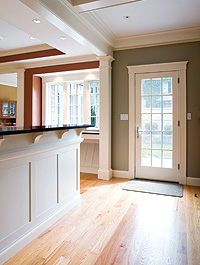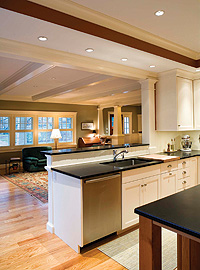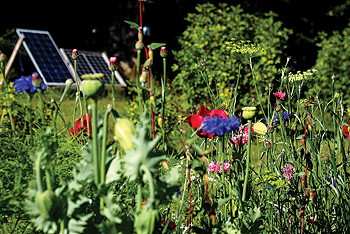It’s Easy Being Green
Nicole Goldman writer
 “Green” is the buzzword of the year. It’s difficult to listen to the news or open up a magazine without learning about a new way to incorporate green concepts into home design. There are many wonderful stories of individuals who have reduced their footprint and their electric bills, and created spectacular homes, but the reality is that few people have the resources to build a brand-new, all-green home from scratch. However, many of us do want to do our part to better the environment and are longing for some practical suggestions on how to do so.
“Green” is the buzzword of the year. It’s difficult to listen to the news or open up a magazine without learning about a new way to incorporate green concepts into home design. There are many wonderful stories of individuals who have reduced their footprint and their electric bills, and created spectacular homes, but the reality is that few people have the resources to build a brand-new, all-green home from scratch. However, many of us do want to do our part to better the environment and are longing for some practical suggestions on how to do so.
Everyone has the opportunity to become involved in the newest wave of green building practices. Whether renovating an old house or building a new one, there are increasing numbers of materials available and the professionals to implement these practices. As Ken Vona of Kenneth Vona Construction, Inc. in Waltham says “You just have to ask.”
Shades of Green
Brandon Diem, an architectural designer with Studio 53, who works hand in hand with Fallon Custom Builders, based in Needham, suggests starting with the notion of “shades of green.” It may be difficult on a particular project to go the whole nine yards towards constructing an all-green home, but individual homeowners can take steps, together with their architects and builders, to make their homes more green.
Diem suggests that the process begin in the design phase. Architects can specify green products as they would a standard product. According to Diem: “Architects should specify products that are manufactured in more sustainable conditions. The more you are able to use, the more the green a project becomes.” The initial design can have a great impact as well: “Site orientation, the type of site, how the house will be oriented to the sun for passive day lighting and heating, can help influence the green nature of the project,” Diem says. “It’s the responsibility of the designer to create an efficient building as well, with fewer corridors and doors, meaning less unusable space, as well as specifying materials such as natural cedar shingles on the exterior that will take less maintenance,” he adds.
Spend Now for Future Savings
Most architects and builders agree that the building shell (the walls, windows, roof, foundation, and floor) should be an initial focus in building green. A concrete foundation is inherently green since it contains no synthetic substances, and is brought in from local suppliers (thereby reducing any transportation and the burning of fossil fuels). New products such as blown-in Icynene® insulation and even recycled denim can help make a home more weather tight, which reduces the fuel needed to heat and cool.
 Patrick Ahearn of Ahearn/Schopfer Associates in Boston and Martha’s Vineyard believes in the importance of properly detailing the exterior. “You’ve got to make certain that the vapor barrier is installed correctly so the moisture is channeled away from the interior. Spend a little extra [money] and use rigid foam insulation (blown-in Icynene®, for example). Upgrade the windows to ones that have a high R-value. An R-value is a measure of resistance to heat gain or loss.
Patrick Ahearn of Ahearn/Schopfer Associates in Boston and Martha’s Vineyard believes in the importance of properly detailing the exterior. “You’ve got to make certain that the vapor barrier is installed correctly so the moisture is channeled away from the interior. Spend a little extra [money] and use rigid foam insulation (blown-in Icynene®, for example). Upgrade the windows to ones that have a high R-value. An R-value is a measure of resistance to heat gain or loss.
The higher the number, the better a product is at resisting heat loss.. While some of this jargon is architectural-speak, your builder and architect will be well-versed in the language and can transform your requests for high R-value into product selections for windows and doors that will result in a tighter home.
Reduce and Reuse
Becoming educated with the terms, the materials and the methods that will make renovations or new construction projects more green is a key element in contributing to the environmental solutions we need to employ. The primary environmental concern of “sustainable design,” as green building is also known, is to reducing waste, including carbon emissions, and reusing what is already here.
Ken Vona says his firm is very tuned into the waste they are creating on the construction site. “We’re recycling everything we can. We even have a waste receptacle just for cardboard. You’d be amazed at how much cardboard is generated on each job, from the packaging alone of all the products we use. Our other waste goes to a transfer station where they pick through to separate the woods from the metals from the general debris.”
The Beauty of Downsizing
Jan Gleysteen of Jan Gleysteen Architects in Wellesley has recently completed a “green” home for Wellesley’s Hans Larsen his wife Lynn that encapsulates many sustainable-design ideas. “They came to me and said, we don’t want a 5,000 square-foot home. We want a smaller home that will have a smaller footprint. And we were able to create a 3,500 square-foot home that included their entire program and is environmentally friendly. It has maintenance-free exterior trim that will never rot, called AZEK, and will not need to be thrown away or replaced. The compact plan will make it easier and less expensive to heat and cool. We used Energy Star appliances, windows with high R-value, and sited the home so that the 100 year-old, five-feet in diameter beech tree will shade in the summer and allow passive solar heating in the winter when there are no leaves.” Gleysteen also included design features such as a central chimney that provides extra warmth without requiring extra fuel.
“Our expectation is that houses will get smaller again,” adds Gleysteen. “And though as a profession we are still waiting for more practical building products, we can expect to see more green building materials become available.” On the downside at present, is that some of these materials can require paying a little extra. Recycled materials, engineered wood products (that Gleysteen and other use in all their projects), Energy Star appliances, heating systems, and low-water-usage plumbing fixtures are readily available solutions to building green. “Did you know that low-water-usage toilets could save 40 percent of the water consumption in the United States? Gleysteen asks. “I would advise clients to demand all these products,” says Gleysteen. “Ask the architect and builder: where can I do more?” he adds. “If necessary, invest an extra five percent in the materials even if that means taking out something else that isn’t necessary. Reallocate your resources.”
How Green Can You Be?
It is up to the consumer to make the final decisions about which green materials to use when architects and builders make suggestions to them. Andrew Goldstein, president of Thoughtforms in West Acton has been promoting green building for years. He believes that homeowners must understand that there are trade-offs and that green building is not an all or nothing proposition. “Base your decisions on your comfort level,” suggests Goldstein, “whether this is your budget or your personal ideals. Even in a bigger home, why not make it as green as you can?”
Goldstein, along with the others, advises using good materials that will last longer. This will increase what’s called the lifecycle of the home. In his book Your Green Home (New Society Publishers, 2006), Alex Wilson writes: “In trying to determine whether one product or material is better than another in terms of environmental impact, it is necessary to consider its entire life-cycle: where the raw materials came from, how the material was manufactured, what happens during the use of the material (energy consumption, for example), and finally, what happens at the end of its life.” Wilson’s book is an exceptional resource for those interested in making the right decisions for their home.
 Back to Nature
Back to Nature
Goldstein is also an advocate of geothermal heating systems on which he collaborates with a local engineer. “We have installed double loop systems with very good results,” he says. The systems are installed about four to six feet below the surface of your property where there is a constant temperature. The water-based solution in the tubes circulates through the loops extracting heat from the ground. This heat is then transferred to the geothermal unit, which compresses the extracted heat to a high temperature and delivers it to the home through normal ducting or radiant-heat systems. Geothermal systems can save up to 30 to 70 percent on monthly utility bills. Their upfront cost, however, is substantial, and it will take several years to recoup your investment.
Another natural energy source is solar power, which comes in two varieties for residential use. Solar thermal systems collect the sun’s heat in panels, normally installed on a rooftop. Glycol fluid heats up and sends energy down through to the plumbing system where water is heated for the home’s hot water needs. Solar energy systems use photovoltaic panels which differ in that they collect the sun’s energy and transform this into electric power for the home. While solar thermal systems are available for a modest investment, photovoltaic panels are much pricier and their payback time can be up to twenty years.
It is probably best to keep in mind that these investments should be made as ways to reduce energy consumption rather than for immediate payback opportunities.
Creating a Healthy Home
For the recent renovation of their Admissions Building, Wellesley College worked with Rick Renner, of Rick Renner Architects in Sherborn. “It was an adaptive reuse of a shingle style, historic building from 1904,” says Renner. “While we completely gutted the inside, we remade much of the interior, reusing the existing floor plan as much as possible, restoring the entrance and [adding] a state-of-the-art mechanical system and good windows. We could have taken it further, but the budget was very tight,” he adds. For homeowners, though, Renner knows he can offer a number of enticements. To him, this means an aesthetically-pleasing design, as well as one that provides a healthy environment, another vital tenet of sustainable design. “[We’re] sustaining the life of the occupants by allowing them to live with healthy materials,” he says. “We look at materials that do not off gas, and then add a high level of ventilation, be it filtered air or through windows. Its all about the overall indoor air quality, the environmental quality of the home. And this is important whether someone is concerned about energy or other global concerns.”
“Green building interests me because by paying attention to issues of health and climate, you just create a better house – high level of light, nice relationship to outdoors – [and] being mindful of these green issues and those inputs can lead to a better design,” Renner says.
As the green wave grows, more and more products are becoming available to increase a home’s health, energy use and lifecycle. We’ve all heard about bamboo and cork flooring that come from renewable resources (meaning they will replace themselves quickly and naturally after they are harvested), but there are many more products to consider.
Green kitchens are a vanguard in the use of these items. Recycled countertops, Forestry Stewardship Council (or FSC) certified-wood cabinetry, recycled glass tiling for back splashes and Energy Star and low-water-usage appliances are excellent selections. Linoleum is seeing a comeback with its dynamic color range and eco-friendly composition of burlap, canvas, or felt, bound together with linseed oil, and can be playfully designed to enliven a kitchen, laundry or mudroom floor.
But be careful when selecting “green” products. Every manufacturer out there is beginning to brand themselves with green labels though there is no federal policing to justify these claims. Manufacturers use terms such as “cradle-to-cradle” indicating that the product will never go into a landfill, “eco-friendly” which can mean just about anything, and “sustainable” which should indicate that using the product will not deplete the earth of non-renewable materials. Sustainable products include wood from forests that are being replenished (look for the FSC-certification) and other plant materials such as grasses, bamboo, natural pigments for paints, and natural oils that bind products. Recycled materials are also considered green, so reusing anything from floor boards, to ceiling joists, is an excellent approach. There are number of self-appointed certifying organizations including Alex Wilson’s GreenSpec® Guide and renowned architect Bill McDonough’s MDBC Cradle-to-Cradle (C2C) Benchmarking program. These are not definite sources, but ones that are recognized by the architectural and building professionals as being top arbiters in the field.
Amid all of this advice, it is easy to become confused and overwhelmed. Seek advice from professionals who are trained or being trained in certifiable green practices. Architects with LEED certification have been through specific training. Builders who offer an Energy Star home-building approach are indicating that they too have been trained to build energy-efficient homes. And keep reading and learning more about what being “green” means and how you can make it a part of your everyday life.



recent comments